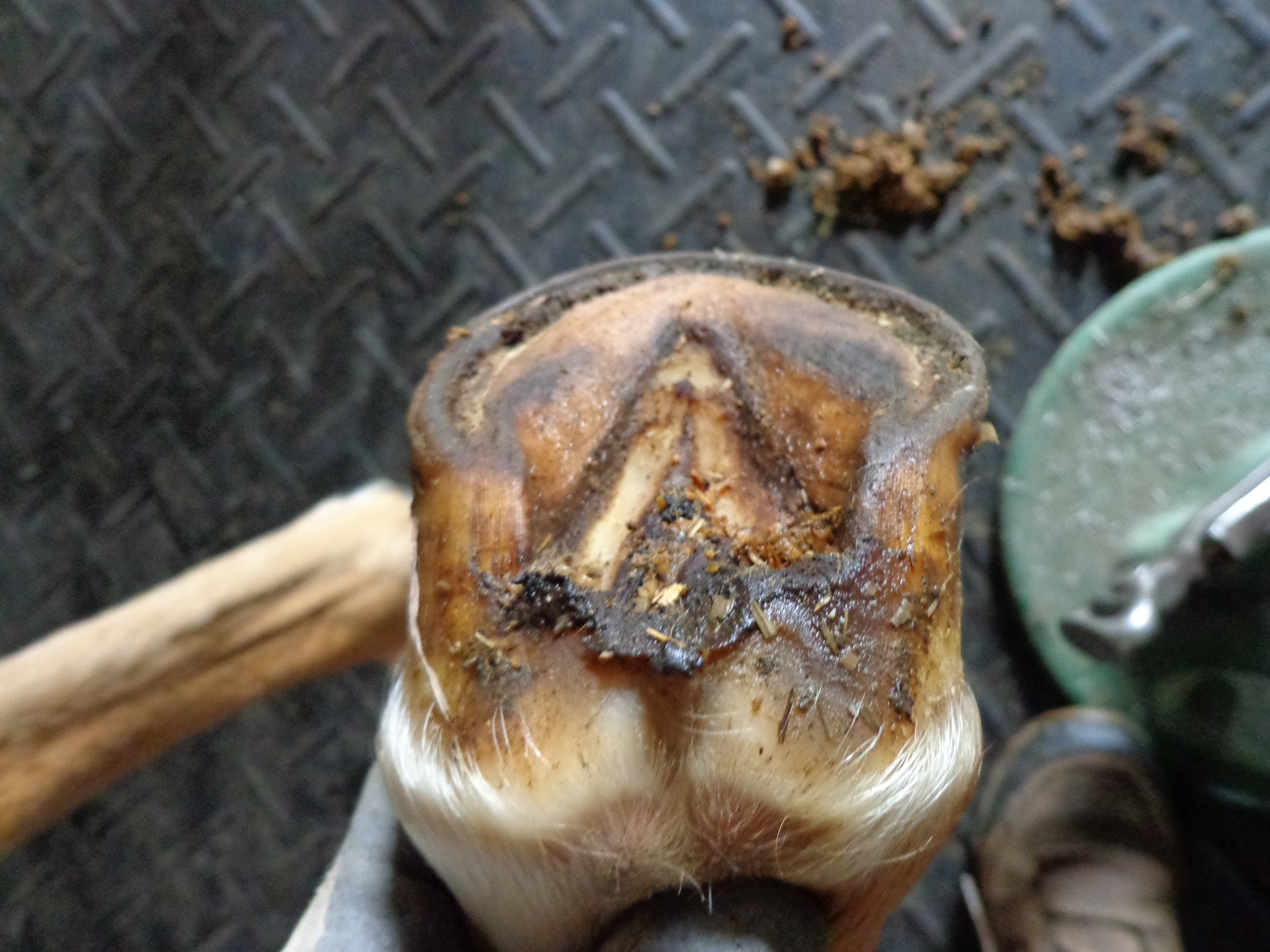Hoof contraction
Every foal hoof has long toes and high heels at birth (diving devices for a safe delivery). About half of the hoof capsule needs to be worn down after birth. This requires movement in a fairly natural environment beginning within the first hours after birth.
There is a lot out there in the trimmer world about fighting and treating thrush. But there is hardly any material there in the first place that could be eaten away by thrush. The back of the hoof is unfinished at birth. At the same time, as the hoof capsule needs to be worn down, proper stimulation of frogs, bulbs, walls, the white line, bars, internal structures need to happen. Otherwise structures will go in to atrophy. The activation of true heels also fails if those processes do not take place.
Atrophy of the frogs, bulbs and internal structures as well as lack of true heels are in direct relation to hoof contraction. Fixed metal shoes might contribute to further contraction but it is not the underlying cause. Over the years I dealt with many contracted hooves which never had any form of shoes attached to them. With or without shoes, the unreleased false heels can contract inwards in an atrophied foot. However, not every atrophied hoof contracts. It really depends on the enforced decision a foal makes very early on about how to compensate for the unfinished hoof.
Due to a failed reduction of the hoof capsule right after birth, combined with the unfinished back of the foot (true heels, bulbs, internal structures), a lot of foals tuck the front legs behind the vertical (enforced decision). The famous scenario of toe first landing is a result. Most horses have problems walking on their own bare feet in the front. Horses endure injuries from the unfinished back of the foot in the hinds as well but are able to compensate differently. Most horses toe out with the hinds (often turn out the entire hind leg) and use the medial half of the hoof capsule for weight loading. This is different from naturally asymmetric hind hooves. The front hooves usually need longer to heal than the hinds. The fundamental problem applies to fronts and hinds.
trimmed from July 2013 – December 2024
Quarter Horse Ace was born in June 2012 in western Canada. Ace was shipped across the country as a weanling. After his arrival on the east coast he was kept in a stall on wood shavings for quite a while. When I started trimming him in July of 2013 I found Ace stuck with his pasterns still stretched, weak fetlock joints, unfinished baby hooves with unreleased long shanks or false heels. (We can safely assume an unnatural environment at birth and lack of movement in the first months of his life.) There was complete atrophy of the frogs, bulbs, soles, bars and internal structures. The outside walls of the hoof capsules were severely bruised. Ace toed outwards with all four. His hooves were already deformed at such a young age. He further developed a broken back axis stance in the front and a crooked right hind pastern. He tent to lean on the side of the hoof capsules. Due to the lack of true heels, internal structures, frogs and bulbs the front hooves soon contracted. For quite some years, the soles and bars were protected by a hard (almost shell-like) layer of horn.
By 2020 Ace clearly entered an important phase of the healing journey. In April of 2021 the layer of shell-like horn turned into crumbly white sole horn which was then ready to be removed. Over the years Ace improved his stance and the bruising on the outer hoof walls as well as soft tissue bruising subsided. Compromised and compressed tissue was released through a few abscesses.
Ace is ridden barefoot since he was started under saddle. From 2021 onward this golden boy makes his young owner proud competing. In 2023 they took home a second place in barrel racing and a first place in pole bending. Photo credit: CKPhotography

Closing note: Ace lives in a herd in a large paddock without green grass pasture, over the summer months with 24/7 freedom to move and he is stalled overnight in the winter. Longer periods of standing (on wooden floor with shavings) caused set-backs in the healing. His hooves tend to re-contract and grow towards a wry-foot as Ace tends to lean on the side of his hoof capsules. In Ace's case hoof contraction was not caused by metal shoes as he never had any. Also it was not thrush eating away his frogs and bulbs as his hooves were in atrophy to begin with.






Image 1: Left front pre-trim July 2013
Image 2: Left front pre-trim July 2013
Image 3: Left front pre-trim December 2019 note the bruised soft tissue and the rubber like skin of the bulbs
Image 4: Left front pre-trim October 2024
Image 5: Left front lateral pre-trim July 2013
Image 6: Left front lateral post-trim November 2023 — he still shortens his feet via divergent hooves; healthier bulbs emerging from further back bringing the hooves more under the bone column.
Photos: Gudrun Buchhofer